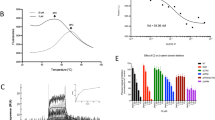Abstract
Accumulation of the Wnt pathway effector β-catenin is a hallmark of a number of cancers, including colon cancer. As β-catenin accumulates in the cell, it forms a complex with Tcf family transcription factors and activates the transcription of several critical genes involved in cell proliferation. Because Tcf4 is the predominant Tcf factor present in colon cancer cells, drugs that specifically disrupt the β-catenin–Tcf4 complex could be useful in treating colon cancers. Earlier structural and biochemical studies demonstrated that the central region of the β-catenin binding domain of Tcf is essential for anchoring Tcf to β-catenin via two conserved lysines in β-catenin (called the charged 'buttons'). Here we report the crystal structure of a β-catenin–Tcf4 complex at 2.0 Å resolution. Our structural and mutagenesis studies show that Tcf4 docks specifically to β-catenin using several distinct conformations in its essential central region. These conformations allow different glutamate residues in the central region of Tcf4 to form a salt bridge with the same critical charged button, Lys 312 of β-catenin. We propose that this interaction may be the first event in β-catenin–Tcf4 recognition.
This is a preview of subscription content, access via your institution
Access options
Subscribe to this journal
Receive 12 print issues and online access
$189.00 per year
only $15.75 per issue
Buy this article
- Purchase on Springer Link
- Instant access to full article PDF
Prices may be subject to local taxes which are calculated during checkout




Similar content being viewed by others
Accession codes
References
Korinek, V. et al. Science 275, 1784–1787 (1997).
Morin, P.J. et al. Science 275, 1787–1790 (1997).
Polakis, P. Genes Dev. 14, 1837–1851 (2000).
Bienz, M. & Clevers, H. Cell 103, 311–320 (2000).
Roose, J. & Clevers, H. Biochim. Biophys. Acta 1424, 23–37 (1999).
He, T.C. et al. Science 281, 1509–1512 (1998).
Tetsu, O. & McCormick, F. Nature 398, 422–426 (1999).
Behrens, J. et al. Nature 382, 638–642 (1996).
Molenaar, M. et al. Cell 86, 391–399 (1996).
van de Wetering, M. et al. Cell 88, 789–799 (1997).
Omer, C.A., Miller, P.J., Diehl, R.E. & Kral, A.M. Biochem. Biophys. Res. Commun. 256, 584–590 (1999).
von Kries, J.P. et al. Nature Struct. Biol. 7, 800–807 (2000).
Knapp, S. et al. J. Mol. Biol. 306, 1179–1189 (2001).
Huber, A.H., Nelson, W.J. & Weis, W.I. Cell 90, 871–882 (1997).
Graham, T.A., Weaver, C., Mao, F., Kimelman, D. & Xu, W. Cell 103, 885–896 (2000).
Huber, A.H. & Weis, W.I. Cell 105, 391–402 (2001).
Conti, E., Uy, M., Leighton, L., Blobel, G. & Kuriyan, J. Cell 94, 193–204 (1998).
Conti, E. & Kuriyan, J. Structure Fold Des. 8, 329–338 (2000).
Poy, F., Lepourcelet, M., Shivdasani, R.A. & Eck, E.J. Nature Struct. Biol. 12, 1053–1057 (2001).
Otwinowski, Z. & Minor, W. Methods Enzymol. 276, 307–326 (1997).
Navaza, J. Acta Crystallogr. A 50, 157–163 (1994).
Brunger, A.T. et al. Acta Crystallogr. D 54, 905–921 (1998).
McRee, D.E. J. Struct. Biol. 125, 156–165 (1999).
Laskowski, R.A., MacArthur, M.W., Moss, D.S. & Thornton, J.M. J. Appl. Cryst. 26, 283–291 (1993).
Kraulis, P.J. J. Appl. Crystallogr. 24, 946–950 (1991).
Merritt, E.A. & Murphy, M.E.P. Acta Crystallogr. D 50, 869–873 (1994).
Nicholls, A., Sharp, K.A. & Honig, B. Proteins 11, 281–296 (1991).
Acknowledgements
We wish to thank A.M. Kral and C.A. Omer (Merck) for the Tcf4 construct, and E. Merritt, C. Verlinda, R. Klevit and R. Moon for critical comments on the manuscript. This work was supported by NIH grants to D.K. and W.X. T.G. was supported by a NIH training grant. Diffraction data were collected at the Advanced Photon Source of Argonne National Laboratory, which is supported by the NIH and NSF.
Author information
Authors and Affiliations
Corresponding author
Rights and permissions
About this article
Cite this article
Graham, T., Ferkey, D., Mao, F. et al. Tcf4 can specifically recognize β-catenin using alternative conformations. Nat Struct Mol Biol 8, 1048–1052 (2001). https://doi.org/10.1038/nsb718
Received:
Accepted:
Published:
Issue Date:
DOI: https://doi.org/10.1038/nsb718
This article is cited by
-
Berberine nanostructures attenuate ß-catenin, a key component of epithelial mesenchymal transition in lung adenocarcinoma
Naunyn-Schmiedeberg's Archives of Pharmacology (2023)
-
Synthesis, and docking studies of novel heterocycles incorporating the indazolylthiazole moiety as antimicrobial and anticancer agents
Scientific Reports (2022)
-
An SETD1A/Wnt/β-catenin feedback loop promotes NSCLC development
Journal of Experimental & Clinical Cancer Research (2021)
-
Design and Synthesis of a Novel Antimicrobial Peptide Targeting β-catenin in Human Breast Cancer Cell lines
International Journal of Peptide Research and Therapeutics (2021)
-
C-demethylation and 1, 2-amino shift in (E)-2-(1-(3-aminophenyl) ethylidene)hydrazinecarboxamide to (E)-2-(2-aminobenzylidene)hydrazinecarboxamide and their applications
Scientific Reports (2020)



